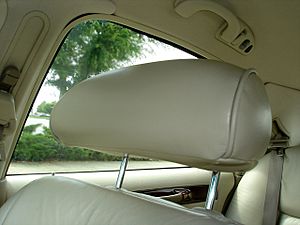Head restraint facts for kids

Head restraints, also called headrests, are a very important automotive safety feature. They are built into the top of car seats. Their main job is to stop your head from moving too far backward during a car crash. This helps protect your neck from injuries like whiplash.
Since the late 1960s, head restraints have been required in cars in many countries. They have saved thousands of people from serious neck injuries.
Contents
History of Head Restraints
The idea for a car headrest came a long time ago. A man named Benjamin Katz got a patent for an automobile "headrest" in 1921. More patents followed in the 1930s and 1950s.
In the mid-1960s, car companies in North America started offering head restraints as an extra feature. By January 1, 1969, the U.S. National Highway Traffic Safety Administration (NHTSA) made them a must-have in all new cars sold in the U.S.
These rules, called Federal Motor Vehicle Safety Standard 202, set specific requirements. For example, head restraints had to be at least 700 millimeters (about 27.5 inches) high. They also had to be strong enough to handle a lot of force without bending too much.
A study in 1982 by NHTSA found that head restraints built right into the seat (called "integral" head restraints) were better at preventing injuries. They reduced injuries by 17 percent. Adjustable head restraints, which you can move up and down, reduced injuries by 10 percent. This difference might be because people sometimes don't adjust the movable ones correctly.
Why Headrests Can Feel Uncomfortable
Sometimes, headrests can feel like they push your head forward. This happens when there isn't enough space, or even "negative" space, between your head and the headrest. It means the headrest is getting in the way of your head's natural, relaxed position.
About 16% of people might feel this discomfort. For most others, there's usually a small gap, so they don't touch the headrest unless there's a crash.
Headrests are designed based on the "average" body posture. When the U.S. National Highway Traffic Safety Administration (NHTSA) updated its rules in 2008, they added a requirement for the "backset." This is the distance from your head to the headrest. They set it at a 55 mm (2.1 inch) gap for the average person. Since not everyone has an "average" posture, this design can cause discomfort for some people.
How Headrests Protect Against Whiplash
For over 40 years, safety experts have been studying how head restraints can prevent neck injuries from rear-end crashes. Many different types of head restraints have been created to protect people from whiplash.
Here are some common types:
- Head restraint: This is the general term for the device that stops your head from moving too far back in a crash. To be most effective, it should limit your head's backward movement to less than 60 mm (about 2.4 inches).
- Integrated head restraint: This type is part of the seat back itself. It's not adjustable and can't be taken off the seat without tools.
- Adjustable head restraint: You can move this head restraint to fit your body better. You might be able to move it up and down (height adjustment) or even tilt it forward and backward (tilt adjustment).
- Active head restraint: This is a smart device that automatically moves into a better position during a crash. It helps protect your head and neck more effectively.
- Automatically adjusting head restraint: This type of head restraint moves by itself when you adjust your seat position. This helps make sure it's always in the right spot for you.
A big problem in preventing whiplash is that many drivers and passengers don't adjust their head restraints correctly. Studies show that a well-designed and properly adjusted head restraint can greatly reduce the risk of neck injury. It does this by limiting how much your head moves compared to your body during a rear impact.
If your head restraint is placed correctly, it can lower your chances of a neck injury by up to 43% in a rear-end collision. However, if it's in the wrong position, it might even increase the risk of injury. Car makers and safety groups are always studying new ways to improve head restraint designs.
For the best protection, your head restraint should be at least as high as the center of your head. This is about 9 centimeters (3.5 inches) below the very top of your head. The distance between your head and the head restraint, called the "backset," should be as small as possible. If the backset is more than 10 centimeters (about 4 inches), it can lead to more neck injury symptoms in a crash.
Because many people don't know how important it is to adjust head restraints, some car companies have created special systems in their cars to help protect people.
Some examples of these advanced systems include:
- Mercedes-Benz A-Class Active Head Restraint (AHR), also known as NECK-PRO.
- Saab (who made the first active head restraint), Opel, Ford, SEAT, Nissan, Subaru, Hyundai, and Peugeot all use Active Head Restraints (like the SAHR).
- Volvo and Jaguar have systems called Whiplash Protection System or Whiplash Prevention System (WHIPS).
- Toyota uses a system called Whiplash Injury Lessening (WIL).
Organizations like the Insurance Institute for Highway Safety (IIHS) test how well head restraints and seat systems work in labs. They check how good these systems are at preventing whiplash injuries. They have found that over 60% of new cars on the market today have "good" rated head restraints.
See also
 In Spanish: Reposacabezas para niños
In Spanish: Reposacabezas para niños
- HANS device


